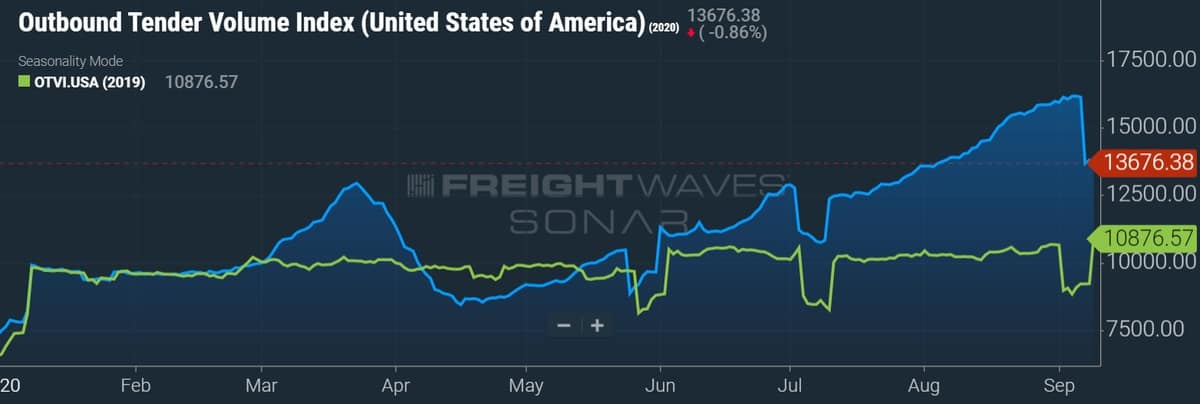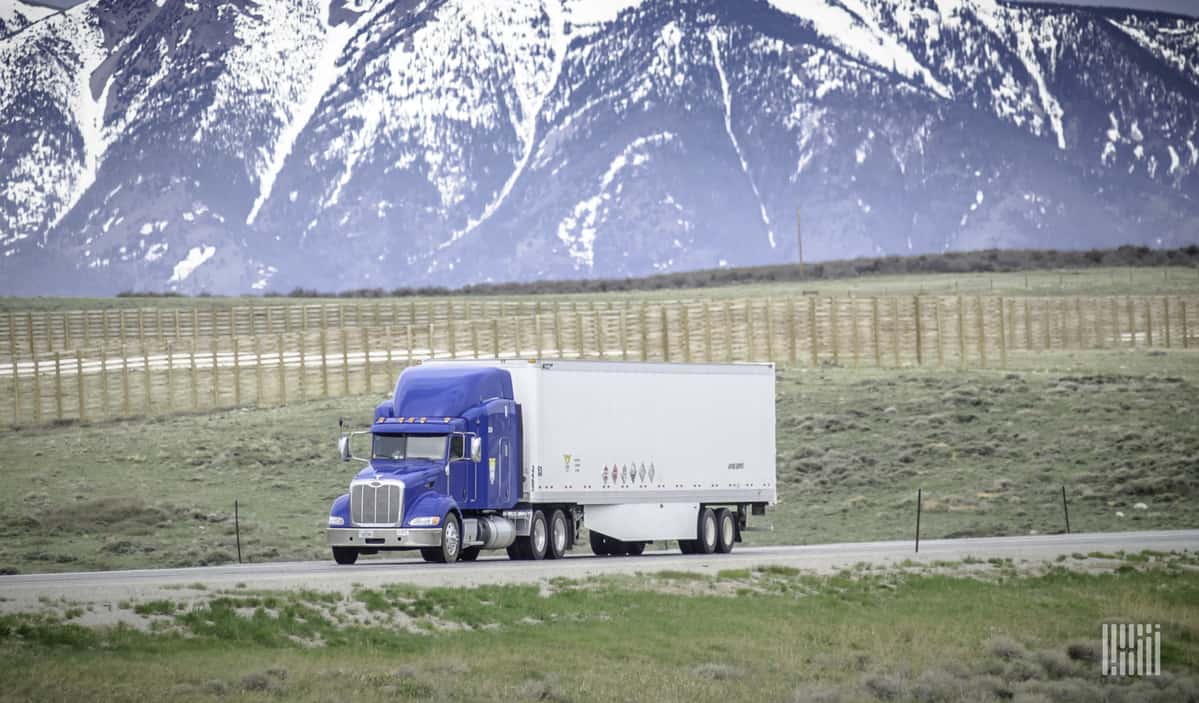Tight capacity and rising demand have carriers encouraged about the future. This dynamic was echoed by several transportation providers appearing virtually at Cowen’s 13th annual Global Transportation & Sustainable Mobility Conference on Wednesday.
Carriers struggle to keep up with rising demand
Schneider National’s (NYSE: SNDR) Chief Financial Officer Steve Bruffett said if the company’s current load tenders fell by 10% to 15%, it would still have more freight than it could handle on a daily basis. The carrier’s truckload (TL) segment normally operates at a 90% contract-to-10% spot freight mix, which can decline to as little as 6% in softer freight markets. It’s at 12% currently as the carrier is choosing to take advantage of higher spot rates.
Eric McGee, executive vice president of highway services at J.B. Hunt Transport Services (NASDAQ: JBHT), said it has seen demand increase incrementally each week over the last six weeks. He said the supply side of trucking continues to suffer from the impacts of the Drug & Alcohol Clearinghouse as well as employment headwinds from COVID-19, which resulted in drivers sitting on the sidelines from either a lack of employment opportunities or as stimulus payments provided sufficient replacement income. He believes these catalysts have diminished the driver pool by more than 100,000 drivers.
U.S. Xpress Enterprises (NYSE: USX) President and CEO Eric Fuller believes the current demand surge is in part due to lean inventories that existed prior to the pandemic. He also said that COVID has shifted buying patterns away from services and experiences to tangible goods that need to be shipped. He believes current elevated demand levels have another two to six quarters before a pullback is seen.
The recent jump in demand is evident in the Outbound Tender Volume Index (SONAR: OTVI.USA). Volumes have accelerated throughout the third quarter, only pausing for Labor Day which occurred five days later this year.

Fuller said the constrained supply dynamic appears likely to linger longer, noting that 30,000 drivers have failed tests, likely keeping them out of the industry for the next couple of years. When adding other headwinds like reduced enrollment at driver schools and unemployment benefits, 2020 has produced 100,000 fewer CDL drivers in the first seven months of the year compared to the same period in 2019. He believes these trends will hold and the industry will exit 2020 down 200,000 drivers year-over-year, an event that will necessitate wage increases in the 15% to 20% range.
Fuller believes the supply deficit will keep the current TL bull market running longer than the historical norm of six to eight quarters.
McGee is expecting a strong peak season in TL and brokerage as current customer indications suggest the demand strength will continue over the next four to six weeks.
Out-of-cycle rate negotiations
Bruffett said spot rates are spiking on both higher demand and lower supply, noting the driver schools are producing fewer graduates during the pandemic. He has seen several shippers throughout the industry struggle to get tendered loads accepted by their carriers and noted that many are looking to renegotiate contracts ahead of the normal cycle to make sure they have capacity.
Bruffett said there were “numerous examples of customers who have struggled to get their loads picked up, their tenders accepted” and they’ve proactively come back to the carriers asking, “‘What is it going to take because we need to get our stuff moved.’”
Fuller said shippers are approaching carriers offering rate increases, sometimes in the form of capacity surcharges. Also, some customers are trying to lock in next year’s rate increase now, hoping to mitigate the spike. He sees rate increases in the 10%-plus range in 2021, given two prior negative bid cycles and an abundance of cost inflation over the last two years.
McGee said contract rates negotiated earlier in the year don’t include the pandemic and will be reset higher. J.B. Hunt’s next bid season opens in 30 to 45 days but McGee sees the changes to rates as more of a 2021 event. He said the company has been working with some shippers already to fix under water contracts as they “don’t expect us to subsidize a pandemic.”
- Analysts continue to raise the bar for trucking companies
- Transportation capacity near 2-year low; pricing surges
- Analyst ups estimates for truckload carriers in 2H 2020
- Sales pop, inventories drop for essential retail; trucking the beneficiary
Intermodal bouncing back but rail service and equipment needs present headwinds
On intermodal demand, Darren Field, J.B. Hunt’s executive vice president of intermodal, said, “In my 26-year career I don’t remember a time when demand was so strong from the customers asking for solutions, asking for more capacity.”
The rapid influx of container imports to the U.S. West Coast with intermodal service to inland destinations has resulted in a container imbalance throughout most provider’s networks. Several companies have implemented surcharges and restrictions to limit volumes or offset the costs involved with excess shipments originating from the West Coast.
Union Pacific (NYSE: UNP) has been reported to have increased its excess cargo surcharge to $3,500 per container. Forward Air (NASDAQ: FWRD) implemented a 5% surcharge and BNSF Railway (Berkshire Hathaway NYSE: BRK.B) has imposed gate restrictions to counter the increased flow.
Field said J.B. Hunt is seeing delays unloading equipment at customer sites as many of those facilities don’t have the warehouse labor needed to handle the inflated volumes and that COVID safety procedures have increased driver wait times. He said J.B. Hunt’s intermodal volumes are increasing in the low single digits but believes the company is not capturing the share it could if rail service and its network of containers were better positioned.
J.B. Hunt’s intermodal volumes appear to be in line with the 3.1% average year-over-year increase reported by the Association of American Railroads over the prior four weeks (intermodal traffic was nearly 25% higher in the recent week but that result was favorably impacted by the timing of Labor Day).
Schneider is seeing more intermodal tenders than it can handle but service issues have impacted its efforts as well. Bruffett said rail ramp inefficiencies are impacting the carrier’s drayage moves as trains are either delayed or multiple trains arrive at the same time. He said Schneider has seen some improvement recently, noting its rail partner in the East, CSX Corp’s, (NASDAQ: CSX ) on-time service is back above 90%. He indicated Schneider is still having service issues in the West.
Field said the problem is the industry went from a period of really low volume and capacity-cutting initiatives to surging demand. He said the railroads are trying to get equipment out of storage and ensure they have the right amount of labor to service higher volumes, but believes it could be after the holiday shipping season before service improves.
The Surface Transportation Board and Federal Railroad Administration both sent letters to the Class I railroads asking the companies to resolve recent service issues by making sure they are appropriately staffed and have the resources needed to meet increasing demand.
On intermodal pricing, Field said J.B. Hunt will continue to honor pricing commitments on contracts negotiated prior to the pandemic. The company’s core pricing was slightly lower in the second quarter and the third quarter isn’t likely to reflect the current market – increased costs, declining rail service metrics and higher demand.
Moving forward, he said he would be “very surprised” to see pricing on contract renewals in the next bid season not reflect the new cost structure and higher demand environment. If the market remains the same, Field expects “a very strong pricing year in 2021.”










